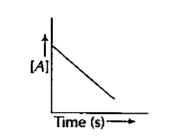For the reaction, 2A+B→A2B,
The rate =k[A][B]2 with k=2.0×10−6 mol−2 L2 s−1
Calculate the initial rate of reaction when [A]=0.1mol L−1,[B]=0.2 mol L−1. Calculate the rate of reaction after [A] is reduced to 0.06mol L−1.Solution in Odia
(a) Case I Initial rate =k[A][B]2 (Given)
=(2.0×10−6mol−2L2s−1)×(0.1mol L−1)×(0.2mol L−1)2
=8.0×10−9mol L−1s−1
(b) Case Il Concentration of A at a particular time
=0.06mol L−1
Amount of A reacted =(0.1−0.06)
=0.04 mol L−1
Amount of B reacted
=12×0.04mol L−1=0.02mol L−1
Concentration of B at a particular time
=(0.2−0.02)mol L−1=0.18mol L−1
Rate =k[A][B]2=(2.0×10−6mol−2L2s−1)×(0.06mol L−1)×(0.18mol L−1)2
=3.89×10−9mol L−1s−1
Topper's Solved these Questions
- SAMPLE PAPER 1 BOOK - ARIHANT PUBLICATIONCHAPTER - SAMPLE PAPER 1 EXERCISE - GROUP C
14 Videos
- SAMPLE PAPER 1 BOOK - ARIHANT PUBLICATIONCHAPTER - SAMPLE PAPER 1 EXERCISE - GROUP A
7 Videos
- QUESTION PAPER 2019BOOK - ARIHANT PUBLICATIONCHAPTER - QUESTION PAPER 2019EXERCISE - GROUP C
11 Videos
- SAMPLE PAPER 4 BOOK - ARIHANT PUBLICATIONCHAPTER - SAMPLE PAPER 4 EXERCISE - GROUP C
7 Videos
Similar Questions
A strip of nickel metal is dipped in a 1 molar solution of Ni(NO3)2 and a strip of silver metal is dipped in a 1 molar solution of AgNO3. An electrochemical cell is created when the two solutions are joined by salt bridge and two strips are joined by wire to a voltmeter.
Answer the following questions.
Write the balanced equation for the overall cell reaction and calculate the cell potential.
View SolutionWhich noble gas is used in atomic reactor ?
View SolutionWhat are oil in water and water in oil type of emulsions ? Give one example of cach type.
View SolutionConsider the reaction, Ak−−→P. The change in the concentration of A with time is shown in the following plot:

(a) Derive the expression for the time required for the completion of the reaction.
(b) Predict the order of the reaction.
View SolutionFor the following reaction: 2A + B +C rarr A_(2)B + C The rate law has been determined to be Rate = k[A][B]^(2) with k = 2.0 xx 10^(-6) mol^(-2) L^(2) s^(-1) For this reaction, determine the initial rate of the reaction with [A] = 0.1 mol L^(-1), [B] = 0.2 mol L^(-1), C = 0.8 mo, L^(-1) . Determine the rate after 0.04 mol L^(-1) of A has reacted.
View SolutionFor the reaction : 2A+B rarr A_(2)B the rate =k[A][B]^(2) with k=2.0xx10^(-6)mol^(-2)L^(2)s^(-1) . Calculate the initial rate of the reaction when [A]=0.1 mol L^(c-),[B]=0.2 mol L^(-1) . Calculate the rate of reaction after [A] is reduced to 0.06 mol L^(-1) .
View SolutionFor the reaction, 2A+B→A2B, the reaction rate = k[A][B]2 with k =2.0×10−6mol−2L2s−1. Calculate the initial rate of the reaction when [A] = 0.1 mol L−1, [B]= 0.2 molL−1. Also calculate the reaction rate when [a] is reduced to 0.06 mol L−1.
View Solutionअभिक्रिया 2A+B→A2B के लिए वेग =K[A][B]2 यहाँ K का मान 2.0×10−6mol−2L2S−1 है । प्रांरभिक वेग की गणना कीजिए , जब [A]=0.1molL−1 एव [B]=0.2molL−1 हो तथा अभिक्रिया वेग की गणना कीजिए, जब [A] घट कर 0.06molL−1 रह जाए ।
View SolutionFor the reaction 2A+B→A,B, the rate =K[A][B]2 with k=2.0x10−6vmol−2L2s−1. Calculate the initial rate of the reaction when [A]=0.1molL−1,[B]=0.2molL−1, Calculate the rate of reaction after [A] is reduced to 0.06molL−1.
View SolutionFor the reaction : 2A+B+CtoA_(2)B+C, the rate law has been determined to be Rate =k[A][B]^(2)" with "k=2.0xx10^(-6)" mol"^(-2)L^(2)s^(1) For this reaction determine the initial rate of the reaction with [A]=0.1" mol L"^(-1),[B]=0.2" mol L"^(-1),[C]=0.8" mol L"^(-1). Determine the rate after 0.04" mol L"^(-1) . Determine the rate after 0.04 "mol L"^(-1) of A has reacted.
View SolutionFor the reaction 2A+B rarr A_(2)B . The rate = k[A] [B]^(2) with 2.0xx10^(-6)mol^(-2)L^(2)s^(-1) . Calculate the initial rate of the reaction, when [A] = 0.1 "mol L"^(-1), [B] = 0.2 "mol L"^(-1) . Calculate the rate of reaction after [A] is reduced to 0.06 "mol L"^(-1) .
View SolutionFor the reaction: 2A+B→A2B the rate k[A][B]2 with k=2.0×10−6mol−2.L2.s−1 . Calculate the initial rate of the reaction when [A]=0.1mol.L−1,[B]=0.02mol.L−1 . Calculate the rate of reaction after [A] is reduced to 0.06mol.L−1 .
View SolutionThe rate equation for the reaction 2A + B rarr products is rate = k[A][B]^(2) . If k at T (K) is 5.0 xx 10^(-6) mol^(-2) L^(2)s^(-1) , the initial rate of the reaction, when [A] = 0.05 mol L^(-1) and [B] = 0.1 mol L^(-1) is
View SolutionFor the reaction : 2A+B rarr A_(2)B the rate =k[A][B]^(2) with k=2.0xx10^(-6)mol^(-2)L^(2)s^(-1) . Calculate the initial rate of the reaction when [A]=0.1 mol L^(-),[B]=0.2 mol L^(-1) . Calculate the rate of reaction after [A] is reduced to 0.06 mol L^(-1) .
View SolutionFor the reaction :2A+B toA_(2)B the rate =k[A][B]^(2) with k= 2.0xx10^(-6) mol^(-2) L^(2)s^(-1) Calculate the initial rate of the reaction when [A]=0.1 mol L^(-1) ,[B] =0.2 mol L^(-1) .Calculate the rate of reaction after [A] is reduced to 0.06 mol L^(-1)
View SolutionFor the reaction : 2A+B to A_(2)B , the rate =k[A][B]^(2) with k=2.0xx10^(-6)"mol"^(-2)L^(2)s^(-1) . Calculate the initial rate of the reaction when [A]=0.1"mol L"^(-1) and [B]=0.2"mol L"^(-1) . Calculate the rate of reaction after [A] is reduced to 0.06 mol L^(-1) .
View Solution
